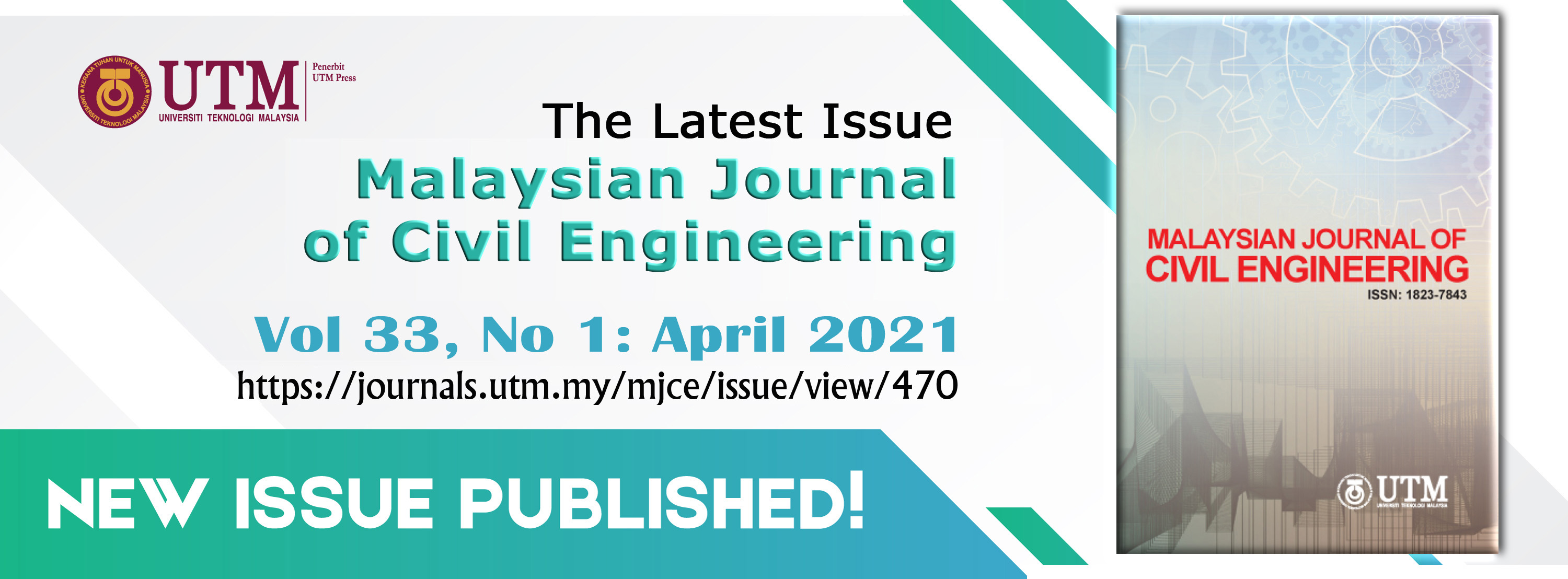ASSESSMENT OF THE BEST PROBABILITY DISTRIBUTION METHOD IN RAINFALL FREQUENCY ANALYSIS FOR A TROPICAL REGION
DOI:
https://doi.org/10.11113/mjce.v33.16253Keywords:
IDF curve, Gumbel, Log Pearson Type III, Normal, Goodness of fit testsAbstract
The Intensity-Duration-Frequency (IDF) curve defines the relationship between rainfall intensities at certain durations and with the frequencies. The IDF Curve is extensively used in many applications such as flood modelling and peak discharge estimation. Over the years, the frequent occurrence of flood has become a great challenge in Kelantan river basin. Herein, IDF curves using frequency analyses based on different distributions were developed and compared. The historical rainfall data at eight rainfall stations for the period of 1985-2019 were selected for the assessment purpose. The Gumbel, Normal and Log Pearson Type III distributions were fitted into the annual maximum rainfall series for durations varying from 30 minutes to 24 hours. The goodness of fit tests were then used to evaluate the performances of each frequency distribution. It was found that the Gumbel distribution gave the highest passing rate followed by the Log Pearson Type III and then the Normal distributions. The Gumbel distribution resulted in respective 86% and 75% passing rate since most of the p-values generated by both the K-S and the Mann-Whitney test were greater than 5% of significance level leading to the acceptance of the null hypothesis. Thus, the Gumbel distribution is suggested for the frequency analyses in this study.
References
Adnan, N. A., Atkinson, P. M., Yusoff, Z. M., & Rasam, A. R. A. (2014). Climate variability
and anthropogenic impacts on a semi-distributed monsoon catchment runoff simulations. In 2014 IEEE 10th International Colloquium on Signal Processing and its Applications (pp. 178-183). IEEE.
Alghazali, N. O., & Alawadi, D. A. (2014). Fitting statistical distributions of monthly rainfall
for some Iraqi stations. Civil and Environmental Research, 6(6), 40-46.
Asma'Suhaimee, N, (2018) The Development of Intensity-duration Frequency Curves for Pahang (Doctoral
dissertation, UMP).
Chang, K. B., Lai, S. H., & Othman, F. (2016). Comparison of annual maximum and partial
duration series for derivation of rainfall intensity-duration-frequency relationships in Peninsular Malaysia. Journal of Hydrologic Engineering, 21(1), 05015013.
Elsebaie, I. H. (2012). Developing rainfall intensity–duration–frequency relationship for two
regions in Saudi Arabia. Journal of King Saud University-Engineering Sciences, 24(2), 131-140.
Galoie, M., Zenz, G., & Eslamian, S. (2013). Application of L-moments for IDF determination
in an Austrian basin. International Journal of Hydrology Science and Technology, 3(1), 30-48.
Government of Irrigation and Drainage Malaysia, (2012). Urban Stormwater Management Manual for Malaysia.
Gubareva, T. S. (2011). Types of probability distributions in the evaluation of extreme floods. Water
Resources, 38(7), 962-971.
Huang, Y. F., Mirzaei, M., & Amin, M. Z. M. (2016). Uncertainty quantification in rainfall intensity duration
frequency curves based on historical extreme precipitation quantiles. Procedia Engineering, 154, 426-432.
Jefrin, N., Bolong, N., Sentian, J., Abustan, I., Mohammad, T. A., & Ayog, J. L. (2017). The Development of
Intensity-Duration Frequency Curve for Ulu Moyog and Kaiduan Station of Sabah. Transactions on Science and Technology, 4(2), 149-156.
Kaboosi, K., & Jelini, R. (2017). The efficiency of detention reservoirs for flood control on the Jafar Abad River
in Golestan province (Iran). Russian Meteorology and Hydrology, 42(2): 129-134.
Kuchment, L. S., & Demidov, V. N. (2013). On the application of copula theory for determination of probabilistic
characteristics of springflood. Russian Meteorology and Hydrology, 38(4): 263-271.
Lee, C. (2005). Application of rainfall frequency analysis on studying rainfall distribution characteristics of Chia
Nan plain area in Southern Taiwan. Crop Environ. Bioinf, 2: 31-38.
LeÅ¡ÄeÅ¡en, I., UroÅ¡ev, M., Dolinaj, D., Pantelić, M., Telbisz, T., Varga, G., ... & MiloÅ¡ević, D. (2019). Regional
Flood Frequency Analysis Based on L-Moment Approach (Case Study Tisza River Basin). Water Resources, 46(6): 853-860.
Liew, S. C., Raghavan, S. V., & Liong, S. Y. (2014). How to construct future IDF curves, under changing climate,
for sites with scarce rainfall records?. Hydrological processes, 28(8): 3276-3287.
Millington, N., Das, S., & Simonovic, S. P. (2011). The comparison of GEV, log-Pearson type 3 and Gumbel
distributions in the Upper Thames River watershed under global climate models.
Mirzaei, M., Huang, Y. F., Lee, T. S., El-Shafie, A., & Ghazali, A. H. (2014). Quantifying uncertainties associated
with depth duration frequency curves. Natural hazards, 71(2): 1227-1239.
Mohd Ariff, N., Jemain, A. A., & Wan Zin, W. Z. (2013, April). Assessment of the intensity-duration-frequency
(IDF) curves for storms in Peninsular Malaysia based on the generalized extreme value distribution. In AIP Conference Proceedings (Vol. 1522, No. 1, pp. 1185-1194). American Institute of Physics.
National Hydraulic Research Institute of Malaysia, (2010). Reviewed and Updated Version of Hydrological
Procedure No. 1.
Ng, C. K., Ng, J. L., Huang, Y. F., Xun, T. Y., & Mirzaei, M. (2020). Tropical rainfall trend and stationarity
analysis. Water Supply.
Ng, J. L., Abd Aziz, S., Huang, Y. F., Mirzaei, M., Wayayok, A., & Rowshon, M. K. (2019). Uncertainty analysis
of rainfall depth duration frequency curves using the bootstrap resampling technique. Journal of Earth System Science, 128(5): 113.
Ng, J. L., Abd Aziz, S., Huang, Y. F., Wayayok, A., & Rowshon, M. K. (2016, August). Analysis of annual
maximum rainfall in Kelantan, Malaysia. In III International Conference on Agricultural and Food Engineering, 1152:11-18.
Ng, J. L., Abd Aziz, S., Feng, H. Y., Wayayok, A., & Kamal, M. R. (2015). Homogeneity analysis of rainfall in
Kelantan, Malaysia. Jurnal Teknologi, 76(15).
Nhat, L. M., Tachikawa, Y., & Takara, K. (2006). Establishment of intensity-duration-frequency curves for
precipitation in the monsoon area of Vietnam. Annuals of Disas. Prev. Res. Inst, 93-103.
Pradhan, B., & Youssef, A. M. (2011). A 100â€year maximum flood susceptibility mapping using integrated
hydrological and hydrodynamic models: Kelantan River Corridor, Malaysia. Journal of Flood Risk Management, 4(3): 189-202.
Wagesho, N., & Claire, M. (2016). Analysis of Rainfall Intensity-Duration-Frequency Relationship for Rwanda. Journal of Water Resource and Protection, 8(07): 706.
















